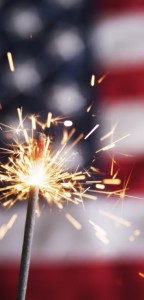A sparkler is a form of firework that you can normally hold safely in your hands. Unlike firecrackers, it is not meant to explode. Unlike roman candles, it does not discharge stars or comet shells. Instead, it burns slowly and steadily while emitting a brilliant, sometimes colored, shower of sparks. In the United States, it is customary to celebrate the Fourth of July with sparklers along with other fireworks display.

In fact, in Delaware, Massachusetts, New York and New Jersey, all kinds of consumer fireworks are not allowed. In Colorado, consumer fireworks that are not explicitly permitted by the state’s law are deemed prohibited.
Fortunately, sparklers are among those explicitly permitted by the state, along with fountains, ground spinners, glow worms, trick noisemakers and other novelty items.
How are sparklers made?
Typically, a sparkler consists of a wire or stick that has been dipped into a slurry or batter of pyrotechnic chemicals, including aluminum, magnesium, iron or zinc dust, potassium chloride, charcoal, and a solution of dextrin and boric acid with water. Other ingredients may be added to produce special effects. For instance, if barium nitrate is added, you will have green sparks.
If strontium nitrate is used instead, you will have red sparks. If ferrotitanium is mixed, you will have golden sparks. The chemicals however have to be exactly proportioned according to formula. Otherwise, there is risk that they may explode.
Once dried, when one end of the chemically-coated wire or stick is ignited, it will slowly burn until it reaches the un-coated part. If made according to exact specifications, the un-coated end of the wire or stick should be safe to hold while the sparkler is in the process of burning.
History of sparklers
Most historians generally credit the Chinese for having invented gunpowder and fireworks around 2,000 years ago. However, it was the Germans who were actually responsible for making the first sparklers in recorded history according to Dennis Manochio Sr., the curator of the Fourth of July Americana & Fireworks Museum in Saratoga, California, and the historian of the American Pyrotechnic Association.
According to Manochio’s account, around the 1850s, the Germans learned to dip wire into a paste of gunpowder and iron dust to make wunderkerzen, literally meaning “sparklers.” In 1894, they introduced aluminum into the formula to create a more brilliant spark shower.
The German firm Octavius Hunt Ltd refined the formula to produce it that were then recognized as the best in the world. Eventually, the German-made sparklers reached the United States. By the 1900s, Americans were producing locally-manufactured it.
Today however, Diamond Sparkler in Youngstown, Ohio, is the last remaining operating sparkler manufacturer in the United States. The over 80-year old company still makes the traditional silver sparklers, although they now also make gold and multicolored varieties. Aside from those manufactured by the company, many of the sparklers that are commercially sold in local stores are already sourced from foreign, particularly Chinese manufacturers.
Sparklers can be dangerous too
While relatively safer than other types of fireworks, it should be noted that a sparkler can give of heat at 1,200 degrees Fahrenheit or more, meaning, it can get hotter than boiling water (212 degrees Fahrenheit) and hotter than burning wood (575 degrees Fahrenheit).
It can easily cause third degree burns and start fires. Smoke inhalation from it is also hazardous to health. Thus, small children should not be allowed to handle or play with it unless closely supervised by an adult.
Some safety tips when using sparklers
This coming Fourth of July, it may do you well to take the following precautions when using it to kick off your celebration:
• Never let children under 5 years old handle sparklers. For children over 5, make sure they wear non-flammable gloves and safety glasses.
Do not let them run around with a lighted sparkler. Make sure they hold the sparklers at full arm’s length and away from their faces, hair and clothing. Make sure they also point their sparklers away from other people, the house, leaves brush or other flammable objects. Do not let them light it by themselves. Show them how to properly have fun with the sparklers without compromising safety.
• Avoid handling sparklers and other fireworks when you have consumed more alcohol than you should. Also, do not let inebriated people get anywhere near your sparklers. Keep a sharp eye for drunks with it who may just carelessly casually throw away their spent or still burning it at your front lawn or yard.
• Never just throw away sparklers. Make sure they are completely extinguished by dunking them in a bucket of water before putting them in the garbage bin.
• Keep a hose or a container of water nearby in case of accidental fires or burns. Have a first aid kit always ready just in case.
• Always light your sparklers one at a time, and avoid keeping them in your pocket as friction or static electricity could also set them off.






